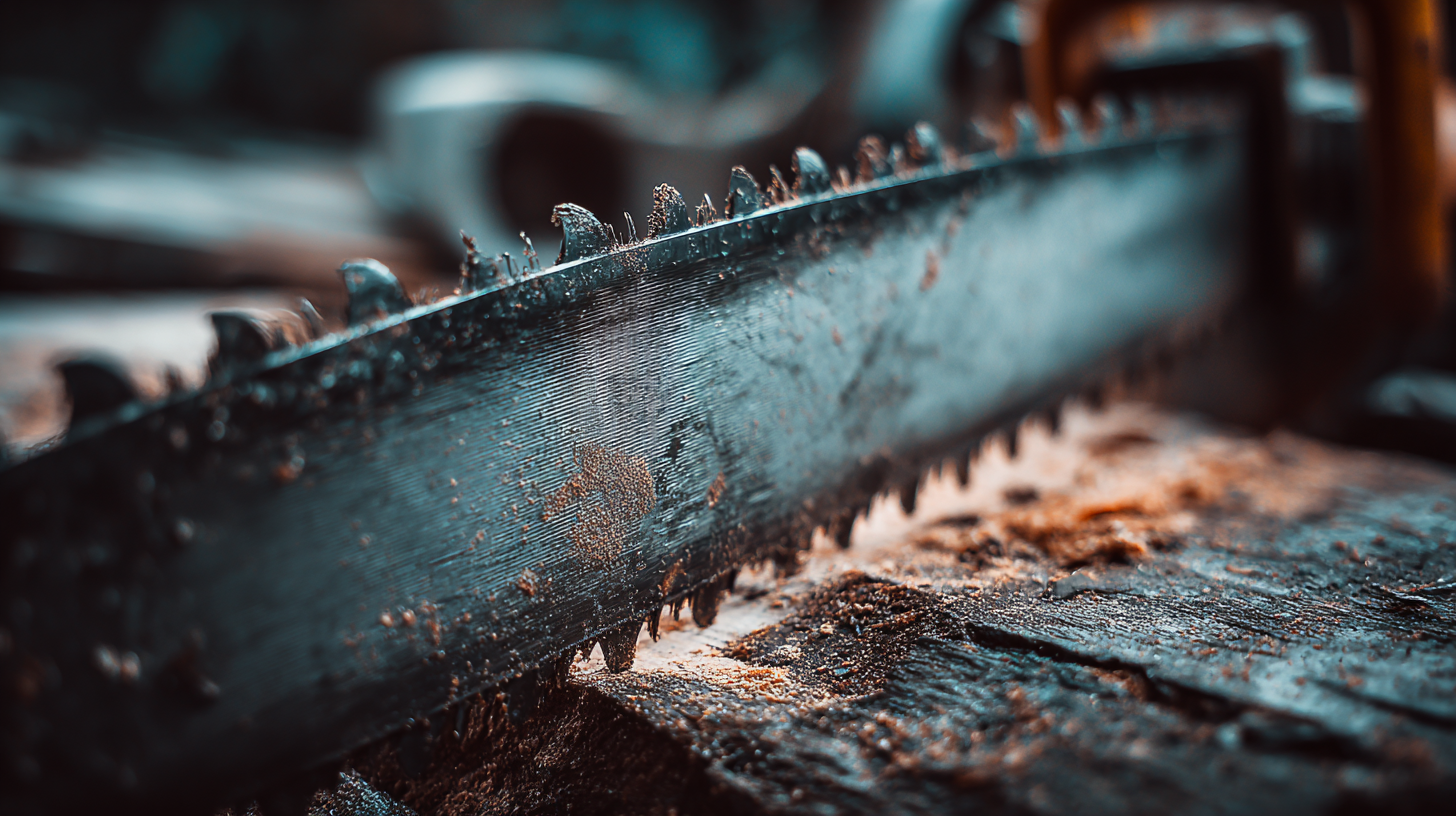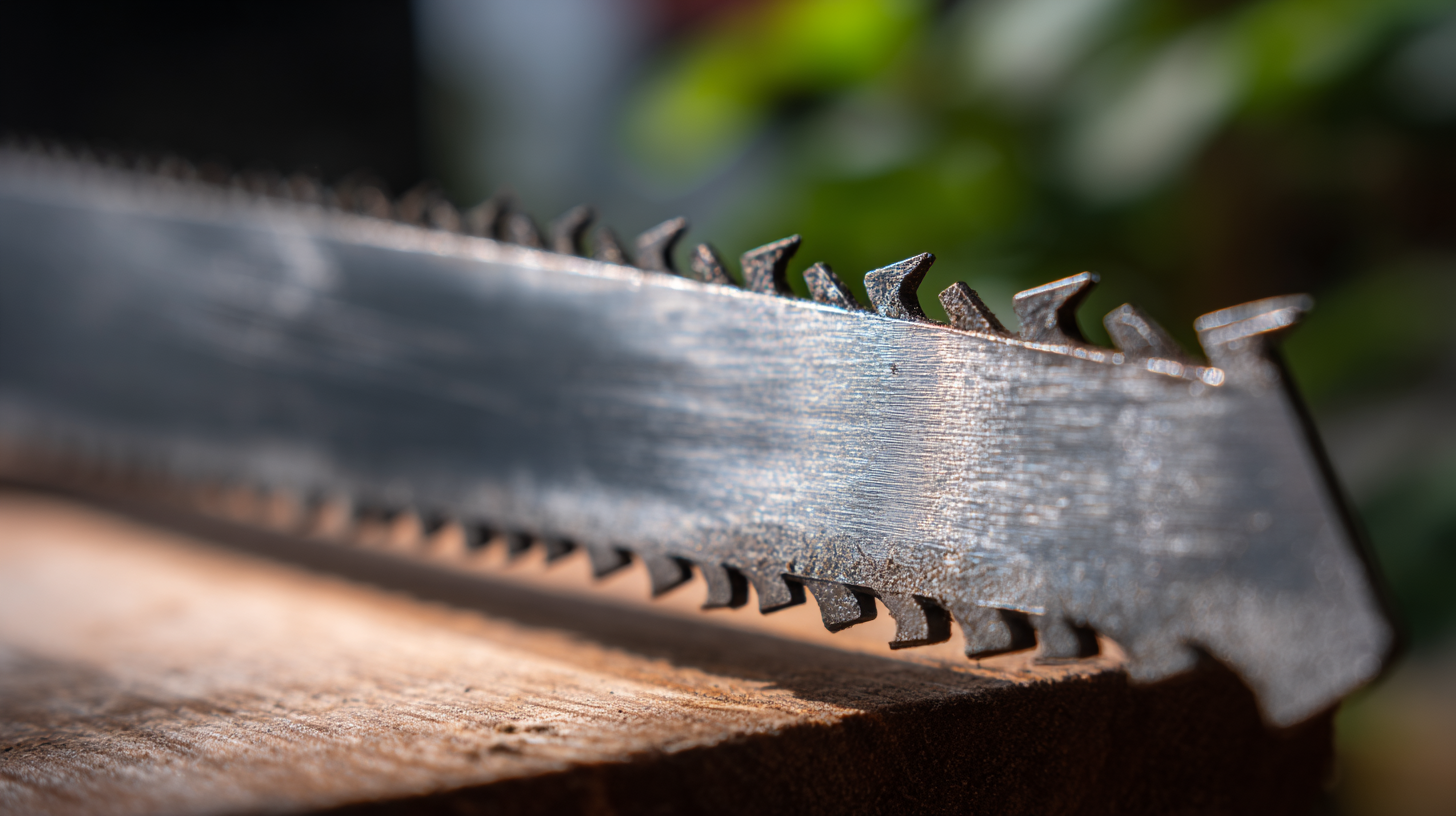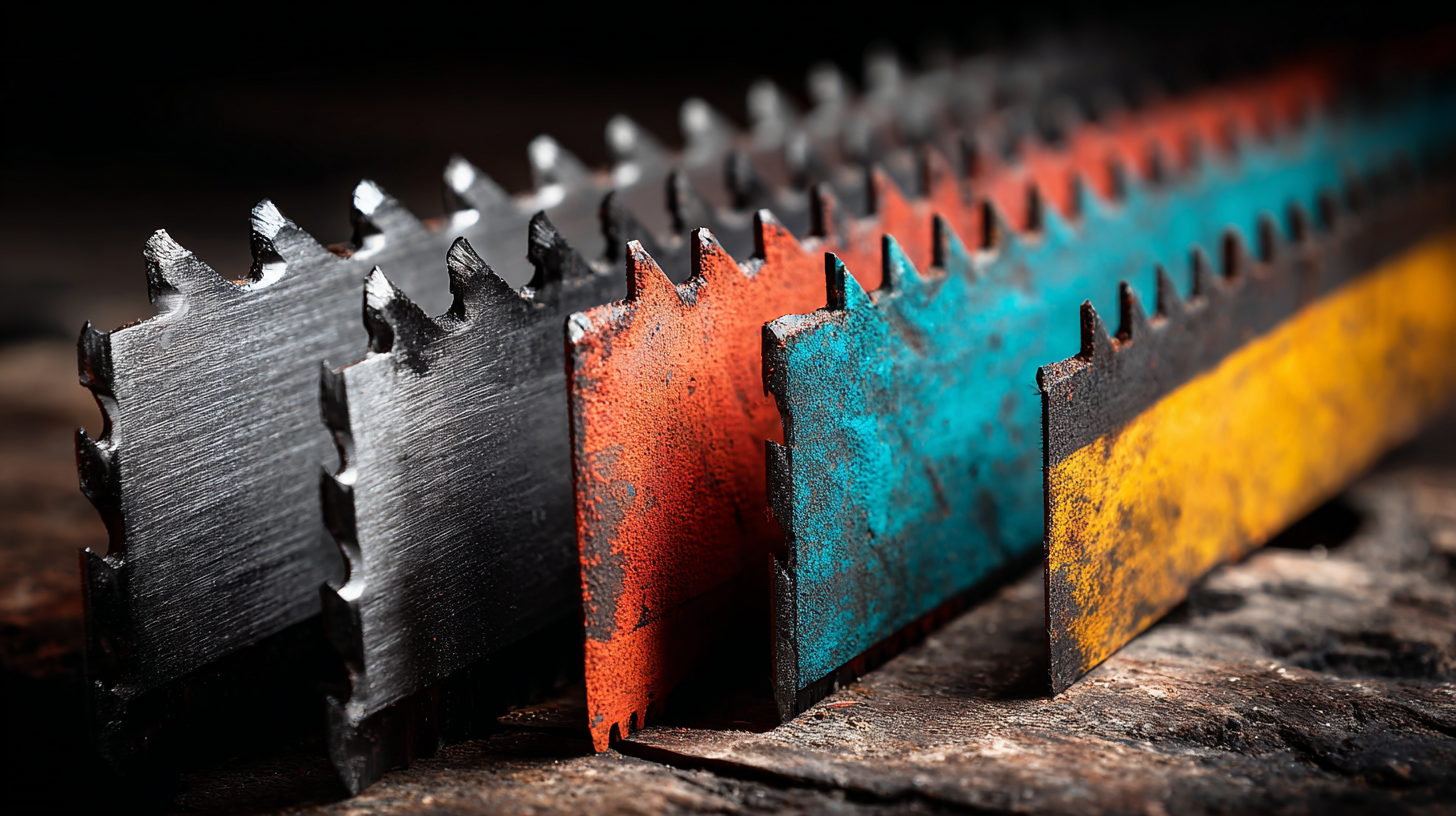The Ultimate Guide to Choosing the Right 16 Inch Reciprocating Saw Blade for Your Projects
Table of Contents
- Understanding the Different Types of 16 Inch Reciprocating Saw Blades Available on the Market
- Key Material Considerations: Choosing Between Bi-Metal, Carbide, and High-Speed Steel Blades
- Assessing Tooth Design: How Tooth Count and Shape Affect Cutting Performance
- Blade Thickness and Flexibility: Selecting the Right Gauge for Your Specific Applications
- Environmental Considerations: Choosing the Right Blade for Wood, Metal, and Composite Materials
- Cutting Speed and Efficiency: Analyzing Industry Benchmarks for Enhanced Performance
- FAQS
- Conclusion
- Related Posts
In the constantly changing world of power tools, picking the right accessories can really make or break your project — whether you're working on a job site or just tackling a DIY project at home. One item that’s been gaining a lot of attention lately is the 16-inch reciprocating saw blade. People love it because it’s so versatile and gets the job done efficiently. If you’ve been looking into it, you’ve probably seen that demand for good-quality reciprocating saw blades is on the rise. Thanks to new materials and tech, we’re getting tools that are tougher and last longer. Wenzhou Yichuan Tools Co., Ltd., founded back in 2003, is really staying ahead of the curve in this area. We specialize in making top-notch electric tool accessories, like jigsaw blades, reciprocating saw blades, and planers. Our goal is to help both pros and DIYers get precise, reliable results every time. Knowing how to pick the right 16-inch reciprocating saw blade is super important for getting the best performance and making your work easier. So, think of this guide as your go-to resource if you're a tool enthusiast or just want to make sure you're doing things right.

Understanding the Different Types of 16 Inch Reciprocating Saw Blades Available on the Market
So, when you're trying to pick out the perfect 16-inch reciprocating saw blade, it’s really helpful to understand the different types out there. Honestly, each kind is made for specific jobs, so finding one that matches your project can save you a lot of hassle. For example, blades meant for cutting wood usually have fewer teeth and are a bit thicker, which basically means they can zip through softer stuff pretty quickly. On the flip side, blades designed for metal tend to have finer teeth and are built tougher—they can handle harder, denser materials without dulling too fast.
And it’s not just about the material; what the blade is made of really matters, too. Bi-metal blades, which combine high-speed steel with carbon steel, are pretty versatile—they last longer and stay flexible, so they can handle all kinds of materials. If you’re dealing with tougher, heavy-duty jobs, though, carbide-tipped blades are where it’s at—they last even longer and give you a cleaner cut, especially with really tough metals or dense stuff. Getting a good grasp of these differences can really help you pick the right blade, ensuring your saw performs its best, no matter what you’re working on.

Key Material Considerations: Choosing Between Bi-Metal, Carbide, and High-Speed Steel Blades
When you're trying to pick out the perfect 16-inch reciprocating saw blade, it's pretty important to understand the different material options out there. Bi-metal blades are a popular choice—they have high-speed steel teeth welded onto a flexible steel body, which gives you a good mix of durability and bendability. These blades are super versatile, great for cutting through all kinds of stuff like wood and metal. Plus, they're tough enough to handle the more demanding jobs without breaking or bending easily.
Now, if you really want to step things up, carbide blades are where it's at. They feature tips made of carbide—tougher than regular steel—which makes them perfect for heavy-duty work. They're especially good if you're dealing with tougher materials like concrete or fiberglass. These are usually favored by pros or serious DIYers tackling big projects. Sure, they tend to be more expensive, but they last longer and cut more efficiently, so many folks see them as worth the investment.
And then there's high-speed steel (HSS) blades. They're not quite as tough as carbide, but they stay sharp for a long time and are great for making precise cuts in soft materials. They tend to wear out less quickly than standard steel blades and are perfect for lighter, more detailed work. Basically, your choice depends a lot on what kind of materials you'll be working with and what kind of projects you've got in mind. Knowing the ins and outs of each type can really help you pick the right blade for the job.
Assessing Tooth Design: How Tooth Count and Shape Affect Cutting Performance
When you're picking out a 16-inch reciprocating saw blade, the tooth design really matters more than you might think. It can totally change how smoothly and efficiently you make your cuts. For example, blades with more teeth tend to give you a cleaner, smoother finish — perfect if you're working with delicate or detailed stuff. On the flip side, blades with fewer teeth are great if you need to cut through thicker, denser materials quickly — speed’s more important than the perfect finish here.
And the shape of the teeth? That's a big deal too. A blade with more aggressive angles can cut through tough materials faster, while a more rounded or blunt design can give you better control and precision. Interestingly, some recent studies in evolution and morphology show that certain tooth shapes, kinda like the extreme saber-tooth cats, are actually pretty ideal for specific tasks. Knowing this stuff helps you pick the right blade for whatever you're working on, ensuring each cut is as efficient and suited to the job as possible. Basically, understanding tooth design makes a big difference — it’s about choosing the right tool for the right job, so your work gets easier and better in the end.

Blade Thickness and Flexibility: Selecting the Right Gauge for Your Specific Applications
Choosing the right 16-inch reciprocating saw blade can really make a difference in your projects. It’s all about understanding blade thickness and flexibility — because these factors play a huge role in how well your cuts turn out. Thicker blades tend to be more durable and stable, making them perfect for heavy-duty cutting jobs. On the flip side, more flexible blades are actually pretty handy for those tricky, detailed cuts or curved shapes, especially when you’re working in tight spots. Interestingly, industry data suggests that flexible blades can boost cutting efficiency by around 20% in more complex tasks, which leads to cleaner cuts and less wasted material.
My tip? Match your blade gauge to what you’re working on. Use thicker blades for straight cuts in tougher materials, and go for flexible ones when you need that extra maneuverability for detailed work. Also, don't forget to consider what the blade is made of — professional advice often recommends carbide-tipped blades if you want something that lasts longer and performs better.
By the way, it’s pretty fascinating how recent advances — like in flexible electronics — show the importance of choosing the right materials. For example, flexible dielectric materials are making waves in antenna and RF sensor tech because they’re lightweight but still high-performing. It really highlights how material flexibility is becoming a big deal across lots of industries, from tools to tech. Bottom line: picking the right blade gauge isn’t just a small detail — it can seriously level up your project results.
Environmental Considerations: Choosing the Right Blade for Wood, Metal, and Composite Materials
When you're picking out a 16-inch reciprocating saw blade, it's really important to think about what kind of material you're cutting. I mean, wood, metal, and those fancy composite materials all need different blade features. For example, blades for cutting wood usually have fewer teeth per inch — they’re built for slicing quickly. On the other hand, if you're working with metal, you’ll want a blade with more teeth so you get cleaner, more precise cuts. And when it comes to those composite materials, like the ones used in wind turbine blades, you’ll need specially designed blades that won’t damage those tricky, layered structures.
**A few tips to help you pick the right blade:**
1. **Match the material:** Always go for a blade that’s made for what you’re cutting. For wood, look for high-speed steel (HSS) or carbide-tipped blades — they work pretty well. For metal, a bi-metal blade is usually your best bet because it’s tough and flexible.
2. **Think about teeth:** The number of teeth really matters. If you need to cut quickly and don’t mind a rougher finish, go for a blade with fewer teeth. But if you're after a really smooth cut, especially for detailed work, a blade with more teeth will do the trick.
3. **Blade thickness:** When working with thicker or heavier stuff, it’s smart to choose a thicker blade. It helps keep things stable and prevents jamming, so your work goes smoother without a hitch.
The Ultimate Guide to Choosing the Right 16 Inch Reciprocating Saw Blade for Your Projects
This chart illustrates the performance of different types of 16-inch reciprocating saw blades used for various materials, highlighting their cutting speed and efficiency.
Cutting Speed and Efficiency: Analyzing Industry Benchmarks for Enhanced Performance
When you're picking out a 16-inch reciprocating saw blade, it's really important to get a good grasp on how fast it cuts and how efficient it is. These factors make a big difference in how smoothly and quickly your project comes together. Basically, the cutting speed can really influence how long the job takes overall. That speed depends on stuff like the tooth design, the material you're working with, and the cutting conditions. For example, bi-metal blades tend to cut through wood or soft metals faster because of their special make-up. They handle heat and wear way better than your average blades, which is pretty handy.
But hey, it’s not just about speed. You also want to look at how the blade performs according to what industry folks say. The top blades usually strike a good balance between being stiff enough to cut straight and still a bit flexible to avoid breaking or bending under pressure. And, honestly, efficiency isn't just about cutting speed — it’s also about how long the blade lasts and how good the finish looks after you're done. When you're trying to figure out which one to buy, it’s worth checking out reviews from other users and comparing tested options so you can find a blade that really lines up with what you need, both in performance and durability.
The Ultimate Guide to Choosing the Right 16 Inch Reciprocating Saw Blade for Your Projects
| Blade Type | Material | Teeth Count | Cutting Speed (in ft/min) | Efficiency (%) |
|---|---|---|---|---|
| General Purpose | High Carbon Steel | 10 | 1500 | 85 |
| Metal Cutting | Bimetal | 14 | 1200 | 90 |
| Wood Cutting | HSS | 6 | 1800 | 88 |
| Composite Materials | Carbide | 8 | 1100 | 92 |
FAQS
: Bi-metal blades offer a balance of durability and flexibility, making them excellent for cutting through a variety of materials, including wood and metal. Their resilience ensures they withstand tougher tasks without breaking or bending.
Carbide blades excel in cutting abrasive materials like concrete and fiberglass, making them ideal for heavy-duty applications and suitable for professional contractors and serious DIY enthusiasts.
Yes, although carbide blades come at a higher price point, their longevity and cutting efficiency often justify the investment, especially for challenging projects.
HSS blades, while not as tough as carbide, offer exceptional sharpness and maintain a sharp edge longer than standard steel, making them suitable for precision cuts in softer materials.
Thicker blades provide greater durability and stability for heavy-duty tasks, while more flexible blades are advantageous for intricate cuts and maneuverability in tight spaces, enhancing cutting efficiency.
Choose a blade gauge that aligns with your specific applications: opt for thicker blades for straight cuts in robust materials and flexible blades for detailed work to achieve optimal performance.
Material choice significantly impacts performance and longevity. Professional recommendations often favor carbide-tipped options for enhanced durability and efficiency in demanding tasks.
Yes, increased flexibility in blades can enhance cutting efficiency by approximately 20% in complex applications, leading to cleaner cuts and reduced material waste.
Recent advancements in related fields, such as flexible electronics, highlight the importance of material flexibility, which can similarly enhance the performance of tool blades across various applications.
Conclusion
When you're on the hunt for the perfect 16-inch reciprocating saw blade for your projects, it’s really helpful to get a good grip on what's out there. There’s quite a variety—from bi-metal and carbide to high-speed steel blades—and each one has its own perks depending on what you're cutting, like wood, metal, or even composites. Plus, things like the tooth design and how thick the blade is can make a big difference in how well it cuts and how smoothly your work goes. Whether you're just doing some DIY stuff or working professionally, choosing the right blade makes all the difference in getting those precise cuts.
Related Posts
-

Unveiling the Future of Carbide Reciprocating Saw Blades at the 137th Canton Fair
-

Unlocking Efficiency with the Best Reciprocating Saw Blades Screwfix for Global Procurement Success
-

Navigating Import Export Certifications for Best Sabre Saw Blades in Global Markets
-

What is the Best Reciprocating Saw Pruning Blade for Efficient Tree Maintenance
-

Navigating the 2025 Trends: How to Choose the Best Cast Iron Reciprocating Saw Blade for Your Needs
-

Ultimate Guide to Choosing the Best Fire Rescue Reciprocating Saw Blades for First Responders
Blog Tags:





